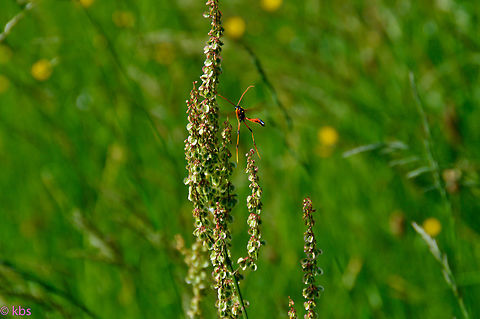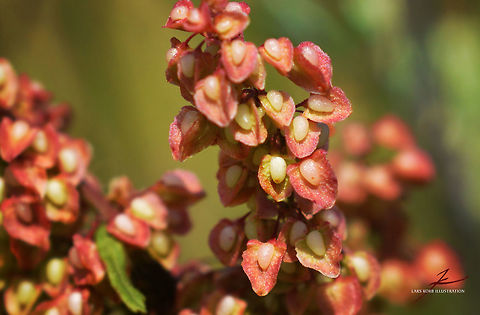
Appearance
Sorrel is a slender herbaceous perennial plant about 60 cm high, with roots that run deep into the ground, as well as juicy stems and edible, arrow-shaped leaves. The lower leaves are 7 to 15 cm in length with long petioles and a membranous ocrea formed of fused, sheathing stipules. The upper ones are sessile, and frequently become crimson. It has whorled spikes of reddish-green flowers, which bloom in early summer, becoming purplish. The species is dioecious, with stamens and pistils on different plants.The leaves are eaten by the larvae of several species of Lepidoptera including the blood-vein moth.

Naming
Several subspecies have been named. Not all are cultivated:⤷ ''Rumex acetosa'' ssp. ''acetosa''
⤷ ''Rumex acetosa'' ssp. ''ambiguus''
⤷ ''Rumex acetosa'' ssp. ''arifolius''
⤷ ''Rumex acetosa'' ssp. ''hibernicus''
⤷ ''Rumex acetosa'' ssp. ''hirtulus''
⤷ ''Rumex acetosa'' ssp. ''vinealis''
Distribution
''Rumex acetosa'' occurs in grassland habitats throughout Europe from the northern Mediterranean coast to the north of Scandinavia and in parts of Central Asia. It occurs as an introduced species in parts of North America.Uses
Common sorrel has been cultivated for centuries. The leaves may be puréed in soups and sauces or added to salads; they have a flavour that is similar to kiwifruit or sour wild strawberries. The plant's sharp taste is due to oxalic acid.In northern Nigeria, sorrel is known as ''yakuwa'' or ''sure'' in Hausa or ''karassu'' in Kanuri. It is also used in stews usually in addition to spinach. In some Hausa communities, it is steamed and made into salad using ''kuli-kuli'' , salt, pepper, onion and tomatoes. The recipe varies according to different levels of household income. A drink called ''zobo'' is made from a decoction of the plant calyx.
In Romania, wild or garden sorrel, known as ''măcriş'' or ''ştevie'', is used to make sour soups, stewed with spinach, added fresh to lettuce and spinach in salads or over open sandwiches.
In Russia and Ukraine it is called shchavel' and is used to make soup called green borscht. It is used as a soup ingredient in other countries, too .
In Hungary the plant and its leaves are known as ''sóska'' . It is called ''kuzukulağı'' in Turkish. In Polish it is called ''szczaw'' .
In Croatia and Bulgaria is used for soups or with mashed potatoes, or as part of a traditional dish containing eel and other green herbs.
In rural Greece it is used with spinach, leeks, and chard in spanakopita.
In the Flemish part of Belgium it is called "zurkel" and preserved pureed sorrel is mixed with mashed potatoes and eaten with sausages, meatballs or fried bacon, as a traditional winter dish.
In Vietnam it is called Rau Chua and is used to added fresh to lettuce and in salads for Bánh Xēo.
In Portugal, it is called or , and is usually eaten raw in saladas or used to make soups. That is identical to its use in Brazil, under the name of .
In India, the leaves are called chukkakura in Telugu and are used in making delicious recipes. Chukkakura pappu soup made with yellow lentils which is also called toor dal in India.
In Albania it is called ''lëpjeta'', the leaves are simmered and served cold marinated in olive oil, it is used in soups, and even as an ingredient for filling byrek pies .
This name can be confused with the hibiscus calyces or hibiscus tea.
References:
Some text fragments are auto parsed from Wikipedia.